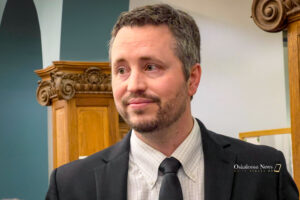Oskaloosa City Manager Shawn Metcalf’s First Six Months: A Deep Look at Growth, Housing, Infrastructure, and the Future of the City
OSKALOOSA, Iowa — When Shawn Metcalf accepted the position of Oskaloosa City Manager in early 2025, he knew he was stepping into a community with a proud history, a strong sense of place, and no shortage of complicated challenges. Six months later, Metcalf says he and his family feel firmly at home in Oskaloosa — attending band concerts on the square, walking the community’s bike trails, and finding themselves welcomed by neighbors. But in the same breath, he acknowledges that the city’s future will depend on how residents, businesses, and elected officials handle pressing questions about housing, infrastructure, and long-term fiscal sustainability.
“I’ve been impressed with the community pride here,” Metcalf said in a recent interview with Oskaloosa News. “The square brings people together in ways that a lot of towns don’t have. At the same time, there are very real issues we have to address if Oskaloosa is going to grow and provide the kind of opportunities people want.”
This article takes a deep look at Metcalf’s early observations and the major city issues now on the table.
Settling Into Oskaloosa
Metcalf arrived in Oskaloosa from Hastings, Nebraska, with his wife Jordan and their three daughters, who now attend second, fourth, and seventh grades locally. His family roots are spread across Utah and Georgia, but Oskaloosa, he says, has already begun to feel like home.
“My kids absolutely love the city band concerts,” he said. “They love the square, the events, and just being part of the community.”
That sense of place is more than sentimental. For a city manager, it is also a way to gauge how residents interact with public spaces and how those spaces contribute to the overall quality of life. Metcalf was struck by the level of investment from community partners, noting that amenities such as the city-wide bike path and athletic facilities are “not really normal for a community this size.”
Such observations matter because they shape how the city thinks about attracting new residents, retaining families, and marketing itself to developers and businesses.
Housing: A Shortage of 1,500 Units
The issue Metcalf returns to repeatedly is housing. By the city’s own estimate, Oskaloosa is short about 1,500 housing units. That number includes everything from affordable rentals to higher-end single-family homes.
Recent projects are underway, including the Burrell Townhomes development of 50 units and the Jefferson Lofts conversion of a former school building into senior and disability housing. Another site known locally as the “Ma and Pa” property is being prepared for redevelopment into low- to moderate-income housing after environmental remediation.
But Metcalf is clear: even with these projects, the shortage remains daunting. “Having 50 units is a step in the right direction, but we need every kind of housing,” he said. “We’re short across the board — lower income, higher income, single-family, multi-family. We’ll take all of them.”
The city is actively working to attract developers, both by building relationships and by offering financial tools. One of the main tools is Tax Increment Financing (TIF), which allows cities to use the increased property tax revenue generated by new development to help pay for the project itself.
Metcalf explained it with a simple example: if a vacant lot valued at $100,000 is developed into a $10 million mixed-use building, the difference in taxable value can be used to finance part of the development. “It’s a way to incentivize growth that might not happen otherwise,” he said.
Oskaloosa is now drafting a formal TIF policy to provide structure and predictability for both the city and developers. “We want to know how much is appropriate to offer so we stay competitive with other communities,” Metcalf said.
Driving demand is the growth of major employers. Mahaska Health has added roughly 200 employees in recent years, and Musco Lighting has added around 300. Those jobs create immediate housing needs that ripple across the community. “Developers see that growth and know there’s opportunity here,” Metcalf said.
Roads, Bypasses, and the Southern Connector
Another major focus for Oskaloosa’s future is transportation. Two projects stand out: the Southern Connector and the Northwest Bypass.
The Southern Connector, a two-year project led by Mahaska County, is in its early groundwork stage. Paving is expected to follow next year. The Northwest Bypass, also under construction, is designed to redirect truck traffic around the city rather than through downtown.
Metcalf acknowledged that bypasses can create tension. On one hand, they reduce congestion and noise in the city center — something band concert attendees will appreciate when semi-trucks no longer rumble past the square. On the other hand, bypasses raise questions about whether traffic will simply drive around Oskaloosa, bypassing businesses as well.
“Our goal is to make sure residents and visitors still have easy ways into downtown,” Metcalf said. “Once jurisdiction transfers from the Iowa DOT to the city, we’ll have more control over Market Street. That opens opportunities to make entrances more welcoming and even more bike-friendly.”
The idea is that while long-haul truckers may prefer to bypass Oskaloosa, most residents and visitors will still come directly into town. Strategic signage and streetscape improvements could help ensure that traffic supports downtown businesses rather than avoiding them.
The Capital Improvement Levy and City Revenues
Few issues stir more debate than taxes. Oskaloosa is considering a Capital Improvement Levy that would help maintain services as state-imposed property tax limits reduce city revenue.
Here’s the situation: property valuations are rising, and residents see their tax bills increase. But under recent state reforms, the city cannot capture all of that revenue. Instead, its share is capped, creating a downward trajectory for the general fund even as valuations go up.
“That’s the biggest revenue source for the city,” Metcalf said. “It funds police, fire, streets, parks, and the library. Without it, we have to decide: do we maintain services through a levy, or do we accept fewer projects and slower street repairs?”
Metcalf emphasizes that levy funds would go strictly to capital projects — police vehicles, fire engines, library repairs, pool improvements, and road reconstruction. “It doesn’t go to salaries,” he said.
Residents will ultimately decide at the ballot box. “There’s no right or wrong here,” Metcalf said. “It’s just what residents want — whether they’re willing to pay a few dollars more per month to maintain services, or whether they prefer to accept reduced services instead.”
Sewer Plant Replacement: A $70 Million Challenge
One of Oskaloosa’s largest looming expenses is replacing its sewer plant. The latest estimate is about $70 million, though Metcalf hopes that careful planning and third-party reviews can reduce that figure.
“We’ll have to bond for the project,” he said, crediting previous councils for raising sewer rates in anticipation. “The cash saved so far covers only a fraction. Bonding is unavoidable.”
The project must strike a balance: it must provide enough capacity to serve future growth, particularly on the west side and at the city’s certified industrial site, but not so much capacity that current ratepayers are overburdened.
“This is essential infrastructure,” Metcalf said. “It’s not optional. The challenge is keeping the cost as low as possible while still planning responsibly for the future.”
Parks, Pools, and Quality of Life
Beyond roads and sewers, Metcalf knows that residents care deeply about quality-of-life amenities. The long-awaited natatorium is finally under construction, with completion expected late next year. “That’s been a big priority for the community,” Metcalf said.
The city is also investing in the aging outdoor pool, reversing earlier discussions about closing it once the natatorium opened. Repairs are planned to extend its life another five to ten years. “The council feels it’s still an important community service,” Metcalf said.
Other projects include the Jefferson Lofts, which will provide senior and disability housing, and the redevelopment of the “Ma and Pa” site into affordable housing. A separate single-family development, Edmundson North, is expected to add 20 new homes.
“If all of these projects come together, Oskaloosa could see more than 100 new units in a short span,” Metcalf said. “That’s far more than the 15 to 20 units the city has added annually in recent years.”
Measuring Progress: KPIs and Community Surveys
Metcalf has emphasized accountability and measurement. Each city department is creating Key Performance Indicators (KPIs) — quantifiable metrics that track how services are delivered. For example, the fire department might measure annual code enforcement visits.
“When you measure results, you can see where things are slipping and make adjustments,” Metcalf said. “It fosters good conversations and ensures we’re being efficient with taxpayer money.”
The city is also considering annual or biennial community surveys to gauge public satisfaction and priorities. “It’s a way to check how we’re doing through the eyes of residents,” Metcalf said.
Sidewalks and the Walkability Debate
One seemingly simple issue — sidewalks — has proven more complicated than expected. Oskaloosa has a “complete streets” policy requiring sidewalks when roads are rebuilt, but residents disagree on whether sidewalks are still necessary in a car-dominated society.
Metcalf acknowledged both sides of the argument. “It’s true that most people drive everywhere now,” he said. “But we also serve people without vehicles, children walking to school, and more residents are using bikes and e-bikes. We have to plan for everyone.”
The council is reviewing sidewalk policies to clarify exceptions and ensure fairness. Metcalf said it’s an example of how even straightforward issues can become complex when applied across a city.
Arts, Culture, and Civic Identity
Oskaloosa has long prided itself on its arts and culture, from historic architecture to community events. Metcalf has proposed creating an Arts and Culture Commission to formalize how the city supports related projects, particularly with funds from the hotel-motel tax dedicated to tourism.
“This is an arts-driven community,” he said. “A commission would provide a structured way to support projects that strengthen both culture and tourism.”
Looking Back, Looking Ahead
Metcalf says his early months have been packed with both challenges and momentum. He points to updated agreements on the joint law enforcement center, steady progress on the natatorium, and housing developments moving from plan to reality. He also notes a redesigned city website and increased transparency, including a new online archive of city awards and donations.
“There’s positive energy right now in housing and economic development,” Metcalf said. “I feel like the council and staff are moving in the right direction, and the community is engaged.”
His family, too, feels settled. “We’ve been welcomed warmly, and it’s felt really good to be here,” he said. “I look forward to serving Oskaloosa for many years.”
















